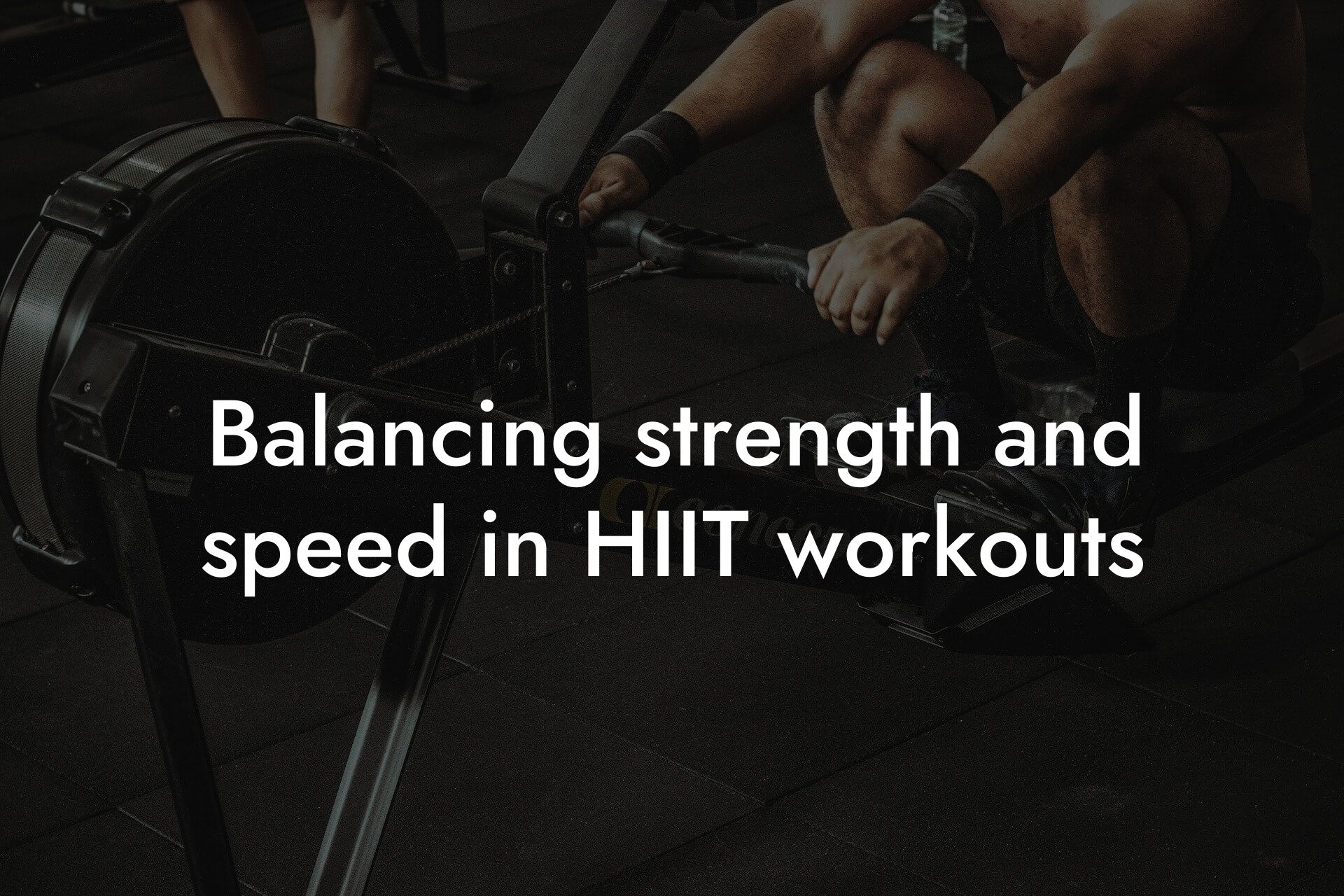As a high-earning professional, you understand the importance of maintaining a strong physical appearance and overall health. High-Intensity Interval Training (HIIT) has become a popular choice for many individuals looking to improve their cardiovascular fitness and burn fat. However, incorporating strength training into your workout routine can significantly enhance your HIIT performance. In this article, we'll explore the benefits of combining strength training with HIIT and provide you with actionable tips to take your fitness to the next level.
Table of Contents
- The Benefits of Strength Training for HIIT Performance
- Identifying Your Weaknesses: A Key to Improving HIIT Performance
- Building a Strength Training Program for HIIT Performance
- Incorporating Strength Training into Your HIIT Routine
- Periodization: The Key to Continued Progress
- Progressive Overload: The Key to Strength Gains
- Frequently Asked Questions
The Benefits of Strength Training for HIIT Performance
Strength training is often overlooked in HIIT programs, but it plays a crucial role in improving overall fitness. By incorporating strength training into your routine, you can:
• Increase your power output, allowing you to perform HIIT exercises with more intensity and efficiency
• Enhance your muscular endurance, reducing fatigue and improving overall performance
• Improve your bone density, reducing the risk of injuries and osteoporosis
• Boost your metabolism, helping you burn fat and maintain weight loss
Identifying Your Weaknesses: A Key to Improving HIIT Performance
Before you can improve your HIIT performance, you need to identify your weaknesses. At Tano Performance Group, we use DEXA machine technology to provide a comprehensive body assessment, giving you a clear understanding of your body composition, bone density, and muscle mass. This information is essential in creating a personalized strength training program tailored to your specific needs.
Building a Strength Training Program for HIIT Performance
A well-structured strength training program should focus on exercises that improve your power, speed, and agility. Here are some essential exercises to include:
• Squats and lunges: Improve your leg strength and power, essential for HIIT exercises like burpees and jump squats
• Deadlifts: Enhance your overall strength, power, and muscle endurance
• Bench press and rows: Improve your upper body strength, essential for exercises like push-ups and mountain climbers
• Planks and core exercises: Strengthen your core, improving your stability and reducing the risk of injuries
Incorporating Strength Training into Your HIIT Routine
Now that you have a solid strength training program in place, it's time to incorporate it into your HIIT routine. Here are some tips to get you started:
• Start with 2-3 strength training sessions per week, focusing on different muscle groups each day
• Incorporate HIIT exercises into your strength training routine, such as jump squats and box jumps
• Use strength training exercises as a warm-up or cool-down for your HIIT workouts
• Gradually increase the intensity and volume of your strength training program as you become more comfortable
Periodization: The Key to Continued Progress
Periodization is a training principle that involves alternating between periods of high-intensity training and low-intensity training. This approach helps to avoid plateaus and prevents overtraining. Here's how to incorporate periodization into your strength training program:
• Alternate between high-intensity strength training sessions and low-intensity HIIT workouts
• Incorporate active recovery days, such as yoga or light cardio, to help your body recover
• Gradually increase the intensity and volume of your strength training program over time
Progressive Overload: The Key to Strength Gains
Progressive overload is a training principle that involves gradually increasing the weight, resistance, or reps over time to continue making strength gains. Here's how to incorporate progressive overload into your strength training program:
• Gradually increase the weight or resistance you're lifting over time
• Increase the number of reps or sets you're performing
• Decrease rest time between sets and exercises
Incorporating strength training into your HIIT routine can have a significant impact on your overall fitness and performance. By identifying your weaknesses, building a strength training program, and incorporating it into your HIIT routine, you can improve your power output, muscular endurance, and overall fitness. Remember to periodize your training and incorporate progressive overload to continue making strength gains. At Tano Performance Group, we're committed to helping you achieve your fitness goals. Contact us today to learn more about our DEXA machine technology and how it can help you take your fitness to the next level.
Frequently Asked Questions
What is HIIT and how does strength training enhance its performance?
HIIT stands for High-Intensity Interval Training, a workout method that involves short bursts of high-intensity exercise followed by brief periods of rest. Strength training is a crucial component of HIIT as it helps improve muscular power, endurance, and overall performance. By incorporating strength training into your HIIT routine, you can increase your anaerobic capacity, boost your metabolism, and enhance your overall athletic performance.
Why is strength training essential for HIIT?
Strength training is essential for HIIT because it helps build the muscular strength and endurance needed to perform high-intensity exercises. Without adequate strength, you may struggle to complete HIIT workouts, which can lead to fatigue, injury, or burnout. By building strength, you can increase your power output, speed, and agility, making HIIT workouts more effective and efficient.
What are the benefits of combining strength training with HIIT?
The benefits of combining strength training with HIIT include improved muscular endurance, increased caloric burn, enhanced athletic performance, and better overall fitness. Additionally, strength training can help reduce the risk of injury during HIIT workouts, improve bone density, and boost metabolism, leading to faster weight loss and improved body composition.
How often should I incorporate strength training into my HIIT routine?
Aim to incorporate strength training into your HIIT routine 2-3 times per week, with at least one day of rest in between. This will allow your muscles to recover and rebuild, making your HIIT workouts more effective and reducing the risk of injury or burnout.
What types of strength training exercises are best for HIIT?
The best strength training exercises for HIIT are those that work multiple muscle groups at once, such as squats, deadlifts, bench press, and rows. These exercises help improve overall muscular strength and endurance, making it easier to perform high-intensity exercises during HIIT workouts.
Can I do strength training and HIIT on the same day?
While it's possible to do strength training and HIIT on the same day, it's generally recommended to separate them by at least 4-6 hours to allow for adequate recovery time. This will help prevent fatigue, reduce the risk of injury, and ensure that you're performing at your best during both workouts.
How long should my strength training sessions be?
Aim for strength training sessions that last around 30-45 minutes, including warm-up and cool-down. This will give you enough time to complete a thorough workout without feeling rushed or exhausted.
What is the importance of proper form and technique in strength training for HIIT?
Proper form and technique are crucial in strength training for HIIT because they help prevent injury, ensure that you're targeting the correct muscle groups, and maximize the effectiveness of your workout. Make sure to focus on proper form and technique throughout each exercise, even if it means using lighter weights or reducing the number of reps.
Can I use bodyweight exercises for strength training in HIIT?
Absolutely! Bodyweight exercises such as push-ups, squats, and lunges are great for strength training in HIIT. They're convenient, require minimal equipment, and can be modified to suit your fitness level. However, if you're looking to increase the intensity of your workout, you may want to consider adding weights or resistance bands to your routine.
How does strength training improve my anaerobic capacity for HIIT?
Strength training improves your anaerobic capacity for HIIT by increasing your muscles' ability to generate force and speed. This allows you to perform high-intensity exercises for longer periods of time, improving your overall anaerobic endurance and athletic performance.
What are some common mistakes to avoid in strength training for HIIT?
Common mistakes to avoid in strength training for HIIT include poor form and technique, inadequate warm-up and cool-down, insufficient recovery time, and overtraining. Make sure to prioritize proper form, listen to your body, and adjust your workout routine as needed to avoid injury or burnout.
How does strength training impact my metabolism and weight loss for HIIT?
Strength training can significantly impact your metabolism and weight loss for HIIT by increasing your resting metabolic rate, helping you build lean muscle mass, and improving your overall athletic performance. This can lead to faster weight loss, improved body composition, and enhanced overall fitness.
Can I do strength training at home for HIIT?
Absolutely! You can do strength training at home for HIIT using bodyweight exercises, resistance bands, or minimal equipment such as dumbbells or a kettlebell. This can be a convenient and cost-effective way to incorporate strength training into your HIIT routine.
How does strength training improve my bone density for HIIT?
Strength training can improve your bone density for HIIT by stimulating osteogenesis, the process by which new bone tissue is formed. This can help reduce the risk of osteoporosis, fractures, and other bone-related injuries, making it an essential component of your overall fitness routine.
What are some strength training exercises that target my core for HIIT?
Some strength training exercises that target your core for HIIT include planks, Russian twists, leg raises, and bicycle crunches. These exercises help improve your core strength, stability, and endurance, making it easier to perform high-intensity exercises during HIIT workouts.
How does strength training impact my mental toughness and motivation for HIIT?
Strength training can significantly impact your mental toughness and motivation for HIIT by increasing your confidence, reducing anxiety and stress, and improving your overall sense of well-being. This can help you push yourself harder during HIIT workouts, stay motivated, and achieve your fitness goals.
Can I incorporate strength training into my HIIT routine if I'm a beginner?
Absolutely! As a beginner, it's essential to start with lighter weights and gradually increase the intensity of your workout as you build strength and endurance. Focus on proper form and technique, listen to your body, and adjust your workout routine as needed to avoid injury or burnout.
How does strength training improve my overall athletic performance for HIIT?
Strength training can improve your overall athletic performance for HIIT by increasing your power, speed, agility, and endurance. This can help you perform better during HIIT workouts, improve your overall fitness, and enhance your athletic performance in other areas of your life.
What are some common strength training exercises for HIIT?
Some common strength training exercises for HIIT include squats, deadlifts, bench press, rows, lunges, and leg press. These exercises help improve overall muscular strength and endurance, making it easier to perform high-intensity exercises during HIIT workouts.
How does strength training impact my recovery time for HIIT?
Strength training can impact your recovery time for HIIT by reducing muscle soreness, improving muscle function, and enhancing overall recovery. This can help you recover faster, reduce the risk of injury, and perform better during HIIT workouts.
Can I incorporate strength training into my HIIT routine if I have any physical limitations or injuries?
Absolutely! If you have any physical limitations or injuries, it's essential to modify your strength training routine to accommodate your needs. Focus on exercises that don't exacerbate your injury, listen to your body, and adjust your workout routine as needed to avoid further injury or discomfort.
How does strength training improve my overall fitness and well-being for HIIT?
Strength training can improve your overall fitness and well-being for HIIT by increasing your muscular strength and endurance, improving your bone density, and enhancing your overall athletic performance. This can lead to improved overall fitness, better body composition, and enhanced overall well-being.
What are some tips for incorporating strength training into my HIIT routine?
Some tips for incorporating strength training into your HIIT routine include starting with lighter weights and gradually increasing the intensity, focusing on proper form and technique, listening to your body, and adjusting your workout routine as needed. Additionally, make sure to prioritize recovery time, stay hydrated, and fuel your body with a balanced diet.
Here are some related articles you might love...
- How DEXA scans can benefit HIIT athletes
- Maintaining muscle recovery with HIIT training
- Balancing strength and speed in HIIT workouts
- Improving cardiovascular endurance with HIIT
- The role of body composition in HIIT performance
- The importance of bone density in HIIT fitness
- Reducing body fat for better HIIT workout results
- Preventing injuries during HIIT sessions
- Nutrition strategies for HIIT enthusiasts
Zak Faulkner
Zak Faulkner is a leading authority in the realm of physical health and body composition analysis, with over 15 years of experience helping professionals optimise their fitness and well-being. As one the experts behind Tano Performance Group, Zak has dedicated his career to providing in-depth, science-backed insights that empower clients to elevate their physical performance and overall health.
With extensive knowledge of DEXA technology, Zak specializes in delivering comprehensive body assessments that offer precise data on body fat, muscle mass, bone density, and overall physique. His expertise enables individuals to make informed decisions and achieve their fitness goals with accuracy and confidence. Zak’s approach is rooted in a deep understanding of human physiology, combined with a passion for helping clients unlock their full potential through personalised strategies.
Over the years, Zak has earned a reputation for his commitment to excellence, precision, and client-focused service. His guidance is trusted by top professionals who demand the best when it comes to their health. Whether advising on fitness programs, nutritional strategies, or long-term wellness plans, Zak Faulkner’s insights are a valuable resource for anyone serious about taking their health and fitness to the next level.
At Tano Performance Group, Zak continues to lead our Content Team revolutionising how professionals approach their physical health, offering unparalleled expertise that drives real results.




